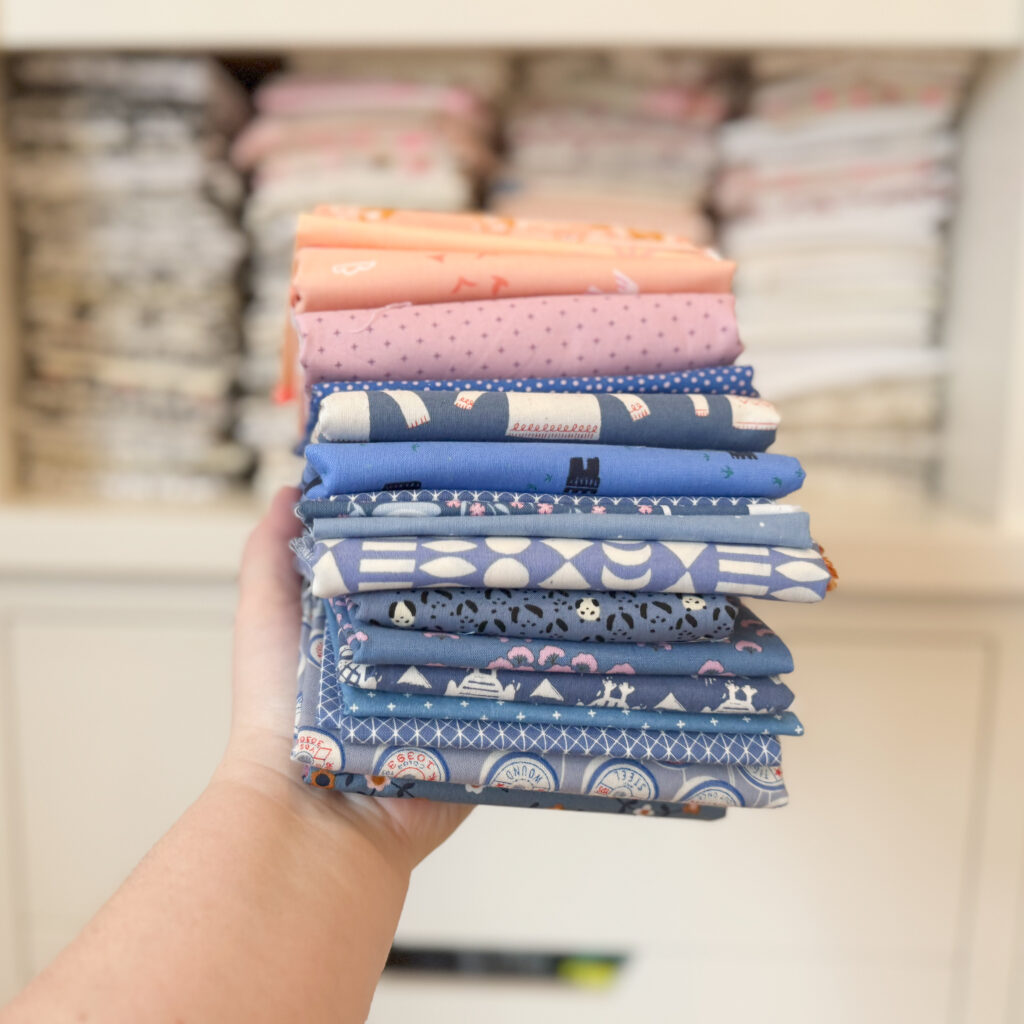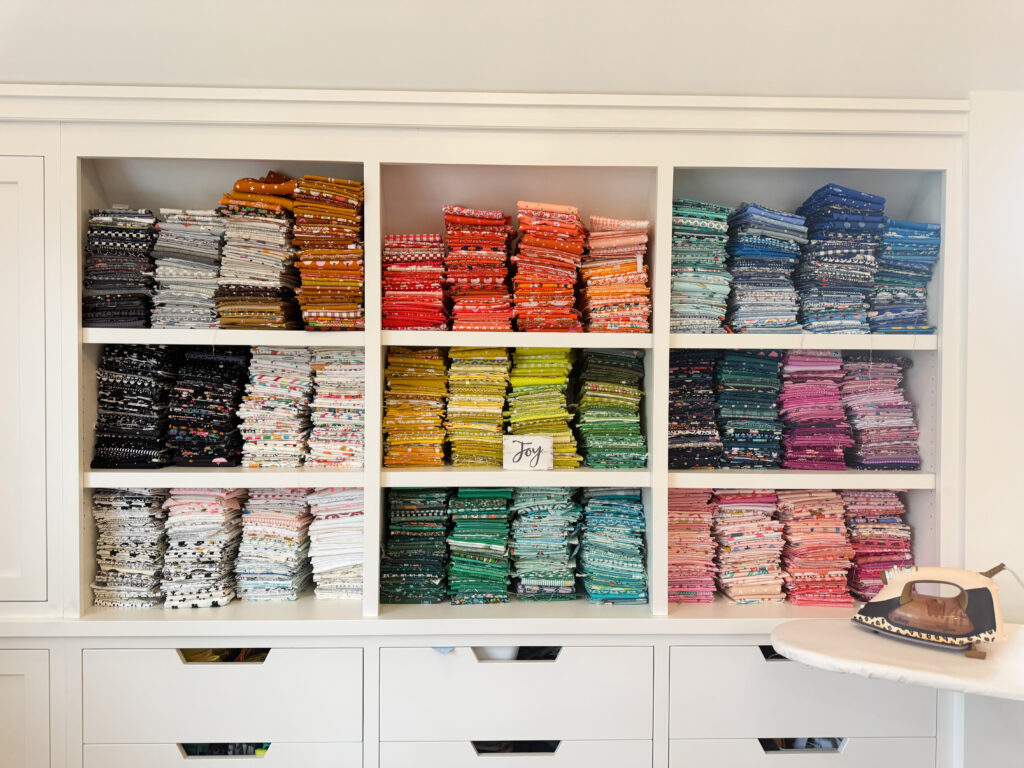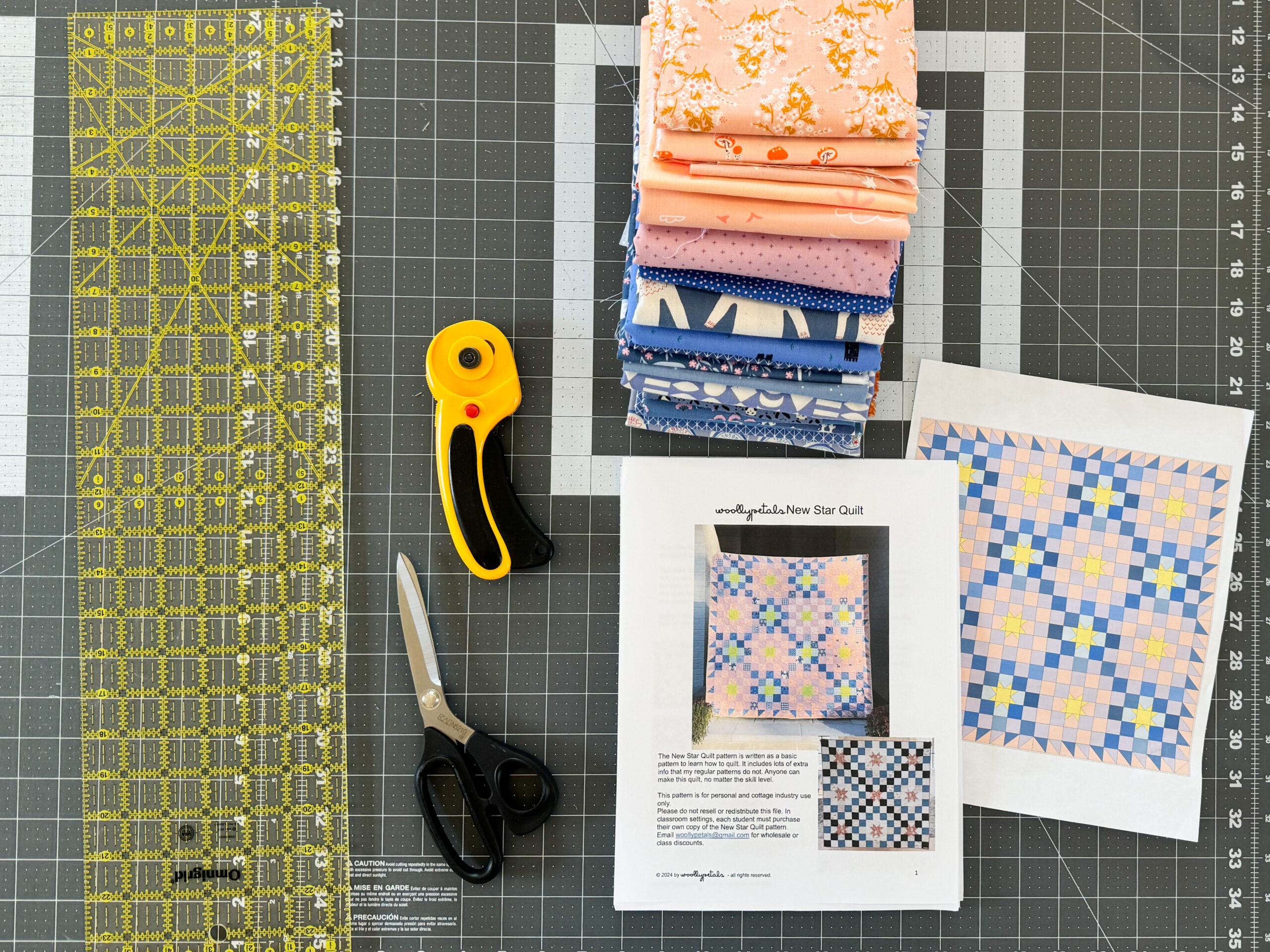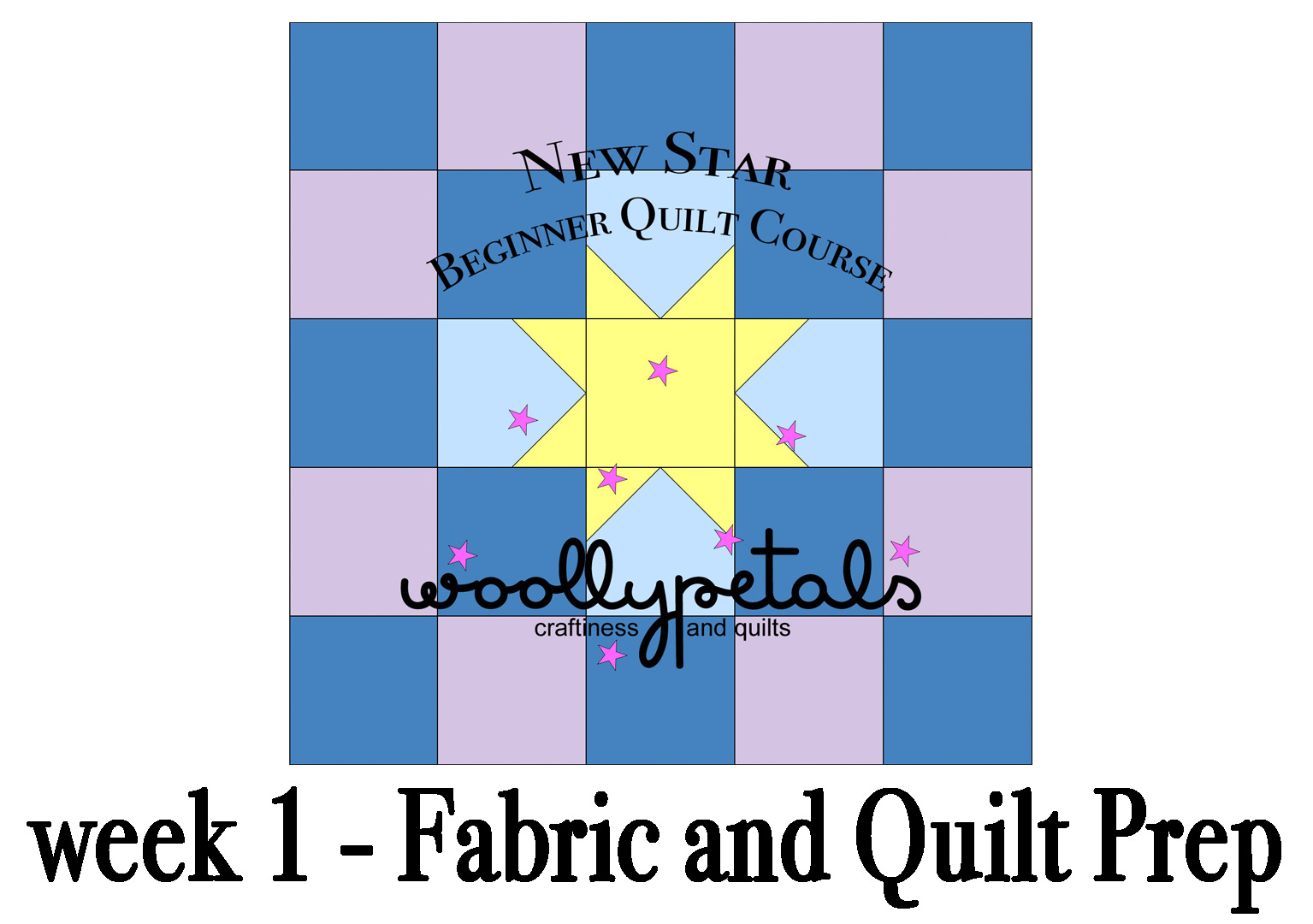Welcome to Week 1 – Fabric and Quilt Prep of the New Star Beginner Quilt Course. I am so excited you are embarking on this new hobby to make Quilts. Or maybe just brushing up on your skills.
Watch the New Star Beginner Quilt Course Intro Video Here.
In Week 1 we will learn about quilting fabric and talk about quilt math as well as how to design your New Star Quilt. So let’s get started.
Check out the cooresponding Youtube Videos linked at the end of the post.

Fabric
Quilting cotton is the most commonly used fabric when sewing a quilt. Quilting cotton is 100% cotton material printed with a design or woven as a solid fabric. You can use other fabric types in quilting, mixed fibers, flannel, thrifted fabric, etc.. But you want to mainly stick with cotton. Because cotton is the easiest to work with in terms of cutting and sewing. It doesn’t have the stretch or slipping that other fabric might have. When using all of the same fabric content a quilt will shrink at a more equal rate as well.
Shrink? Yes, cotton fabric will almost always shrink once washed. So once sewn into a quilt and washed the fabric will crinkle up around the quilting stitches. Some people combat this by pre washing their fabric. Which means they wash the cut yardage of fabric before cutting or sewing it. This pre shrinks the fabric and hinders some of the crinkle that happens to a quilt after washing. Although I would say you will still get some crinkle.
Fabric Manufacturers
Quilt cotton is typically designed by designers. Some designers are exclusive to fabric design and some are artists, surfaces designers, or employed by a fabric manufacturer. Designers will create a collection of fabric using multiple prints that coordinate often in different scales. They will then color these prints with a specific color palette often having several colors of the same print in a collection. The fabric manufacturers sell that fabric collection to us to sew with.
The nice thing about a fabric collection is it all coordinates so you can easily sew up a project that matches without to much effort put into selecting fabrics. Often fabric designers will continue a color way or theme between collections so multiple fabric collections can coordinate with each other. You will find over time that you gravitate towards some designers over others and potentially will have a favorite fabric designer.
Different manufacturers have different cloth bases. What that means is the fabric a manufacturer uses to print the designs on is probably different than other fabric manufacturers. Some will be thicker, higher thread count, feel different, or some other factor will make it different than the rest. You will start to know some manufacturers by their cloth. That said all quilting cotton is pretty similar in weight and can be used with each other no problem.
Fabric Shops – Where we buy quilting cotton
Shopping for quilting cotton is a fun hobby in itself. Whether you shop in person or online. Let’s talk about the difference.
Brick and Mortar Quilt shops are great. It is a fun experience to see and feel quilting fabric in person and see all the fun extras too. Notions like zippers, buttons, labels, ribbon, webbing, thread. Tools like, rulers, rotary cutters, needles, pincushions, seam rippers, etc… There is a whole quilting world of fun things to collect, make quilting easier or more fun that you might not find unless you see them in person. One of the biggest benefits of in person shopping is you can get something same day.
Look up “Quilt Shops” near me to see if you have a local one. Check it out and see what they can offer you in terms of fabric, extras, and classes.
Online quilt shops are a great resource as well. Often they are able to price fabric a little lower than a brick and mortar due to less overhead. I find online shops typically have a larger selection of fabric including whole fabric collections. Something that is not always true in brick and mortar shops due to space. A good thing to check out for Online shops is ship time, wether you’re ordering a pre order or not, and how fast they fulfill your order.
I really recommend shopping both online and in person. I love to check out local quilt shops on vacation. But I really want my local quilt shop to stay in business and so I buy from them and enjoy seeing the ladies who work there. I also love all the online shops I have frequented, some for years and some new ones that friends have opened and I want them to succeed. So let’s support them all!

Shops to shop at
Here are some of the shops I love and have supported for years or whom I know the owner and love what they are doing and want them to succeed. There are so many shops though so find ones that you love.
Incase you live in Chicago Land my local shop is BERNINA of Naperville. They of course sell Bernina Machines, they have longarm services, and they have a great modern selection of fabric including some Heather Ross, Ruby Star Society, and Tula.
Online Shops:
Sewtopia | Hawthorne Supply Co | Nova Quilts | Kristens Craft Room | Stitch Supply Co |
Monograms for Makers | Stash Fabrics | Fabric Pop | Spoonflower (printed on demand fabric)
Check out all the shops above and see what they have. Etsy is a great place to find small business fabric shops too. Don’t forget to check out the notions, patterns, and tools sections too.
Fabric Buying Info
When buying fabric it’s good to know a thing or two about the increments fabric is sold in and how that works. Quilting cotton is typically 40″ – 44″ wide selvedge to selvedge. The selvedges are the sides of the fabric where it was attached to the machine for printing. You cut those selvedges off and use the fabric printed in between to sew with. Some companies print extra wide and cute selvedges to use in your sewing. Fabric is usually folded selvedge edges together and rolled onto bolts, cardboard, in 8-15 yard increments. When you buy fabric from a store you will buy in yardage increments. Most fabric shops will sell in 1/4 yard increments. See my chart below for converting yardage to inches. Feel free to pin the cheat sheets in this post to Pinterest or download to your phone for easy access.
Some other fabric sizes you will run across are precut fabric. Fat quarters are probably the most common and they are the same amount of fabric as a 1/4 yard just cut differently. 1/4 yard is width of fabric (selvedge to selvedge) x 9″ tall, and a fat quarter is half a width of fabric or 22″ wide x 18″ tall. There are also fat eighths and fat sixteenths. Other precut sizes are layer cakes – 10″ squares, charm packs – 5″ squares, and mini charm packs – 2.5″ squares. All with 42 squares of the same fabric collection in the pack. Jelly Rolls are another fabric pre-cut; 40 strips – width of fabric x 2.5″ tall from the same fabric collection. Some designers will write patterns specifically for these pre cut sizes. My Floored10 quilt is adapted from my Floored quilt to fit Layer Cakes.

Quilt Prep
For Week 1 – Fabric and Quilt Prep to sew your New Star Quilt during the New Star Beginner Quilt Course you will need to purchase the pattern. Purchase the supplies and tools you need to quilt. Check out my post and YouTube video all about supplies. And purchase fabric to make the quilt. So let’s talk a little about how to know how much fabric you need.
For the New Star Beginner Quilt Course the videos will guide you through making the cover quilt. The cover quilt is shown on the cover of the pattern (or the first page) and is 66″ square. It is made of 16 blocks that are 15″ square each, and has an HST (Half Square Triangle) border. The cover quilt is made up of two block layouts constructed the exact same way but the fabric placement changes the look of the two blocks. You will make each of the two block designs 8 times and alternate them in the quilt.
You can make this exact quilt using the same colors as shown on the cover quilt and throughout the pattern. Or you can swap out different colors in place of the existing colors. Just make a note on the fabric requirements page what you are swapping for to easily keep track, and use the color sheet in the back to color in the same design as the cover quilt with you fabric colors.
Then you will use the Fabric Requirements to purchase fabric for your quilt. In the Youtube videos I give a little more explanation on how to calculate if you would like to make one of those fabric more scrappy. I.e. the pink is a single pink fabric in the fabric requirements. But maybe instead you want to use 8 pink fabrics, you can divide the total amount of yardage needed by 8 and get that amount from each of the 8 fabrics. This is how you make any fabric scrappy in a quilt. To calculate; convert yardage to inches first, then divide the inches by the amount of fabrics you want to use and that gives you the height of the fabric in inches for each fabric needed. The fabric always is purchased height X WOF (width of fabric).
The New Star Quilt is fully customizable in size and in design. With the inspiration on pages 2-3 and the coloring page at the end you can make a custom sized quilt and a custom design layout. Once you have colored in your custom layout on the size quilt you want to make, count up how many pieces of each color you need and use page 5 to calculate how much of each fabric you need based on your custom design.
Another way the New Star Quilt can change is by what size square you use to make it. The cover quilt is sewn using 3″ finished squares and there is an option to use 4″ finished squares instead. This will change the size you cut at, the size of the quilt, plus the amount of fabric needed. The construction will be the same either way. Fabric requirements and cutting instructions are shown in both 3″ finished and 4″ finished sizes.
Below is a guide for quilt sizes to help you custom design your own size New Star Quilt or any quilt in the future.

Homework
Once you have decided what fabrics to use on the cover quilt or your custom designed New Star Quilt layout you can buy fabric.
Your Homework for Week 1 – Fabric and Quilt Prep is to watch the Youtube Videos, then do some fabric shopping and buy any supplies and tools you still need to sew with. The Youtube videos will really help a lot as I further explain some of the stuff you have read about today. Check out the New Star Mock Up post for loads of New Star Quilt inspiration.
NSBQC Week 1 Video – Quilt Prep
NSBQC Week 1 Video – Fabric Pull
New Star Quilt pattern on Etsy
I’ll see you back for week 2 where we learn all about cutting out fabric.
Back to the New Star Beginner Quilt Course Page with all the links.
New Star Beginner Quilt Course Supplies and Tools Post.
Community and Questions
Check out @woollypetals posts on Instagram for the New Star Beginner Quilt Course, leave your IG name and when you started the course and make friends with anyone else who has commented. This is a great way to find friends who are just starting out in the quilting world.
Have questions? Need answers right away? I do respond to questions on these posts but if you need an answer asap please reach out via email or Instagram. I am Instagram the most and would be happy to answer any questions you message me there. Typically I hop into email and respond to questions within a day or two.
Thanks so much for starting your quilting journey with woollypetals and the New Star Quilt Course.



One thought on “Week 1 – Fabric and Quilt Prep for the New Star Beginner Quilt Course”